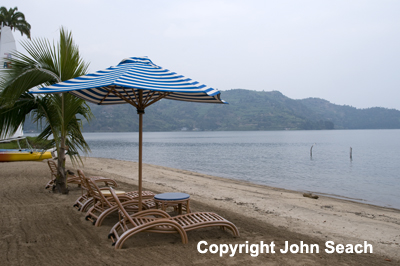Nyiragongo Volcano
nyiragongo.com
Lake Kivu | John Seach
Democratic Republic of Congo
 Lake Kivu is located about 18 km S of Nyiragongo volcano summit. The lake covers an area of around
2400 sq km, the maximum depth is 485 m and the water volume is 500 cubic km.
Lake Kivu is located about 18 km S of Nyiragongo volcano summit. The lake covers an area of around
2400 sq km, the maximum depth is 485 m and the water volume is 500 cubic km.
Water mixing extends from the surface only down to a depth of about 50 m. This means that a large quantity of gas remains dissolved at depth. The lake contains 250 cubic km of carbon dioxide, 55 cubic km of methane, and 5 cubic km of nitrogen.

Resort on the shore of Lake Kivu - John Seach
Historically, lava flows reach the lake on the North-West shore and in the Gulf of
Kabuno. A risk from lava entering Lake Kivu is the disturbance in the stratification of the lake, resulting in a lethal cloud of carbon dioxide and methane around the lake.
Large quantities of methane gas are dissolved below 275 m in the waters of Lake Kivu. In Lake Kivu the methane is held in water layers which form a dynamically stable density stratification.
Carbon dioxide concentration in Lake Kivu is 8% of saturation at a depth of 180 m. Methne concentration is 43 % saturation at a depth of 180 m. This is much lowere than Lakes Nyos and Monoun in Cameroon, which reached saturation before the gas eruptions in 1984 and 1986.
The probability of a disastrous gas outburst with thousands of victims occurring
in the main basin of Lake Kivu may be about 1 to a million for the next
several decades, according to a scientific report in 2002.
Adventure Tours
John has been providing unique tours to the world's most active volcanoes since 1989.
More info on tours...
Quick Links
Film and Television
John Seach provides high-quality professional services to the film and television industry with many years volcano filming experience worldwide.
More info...